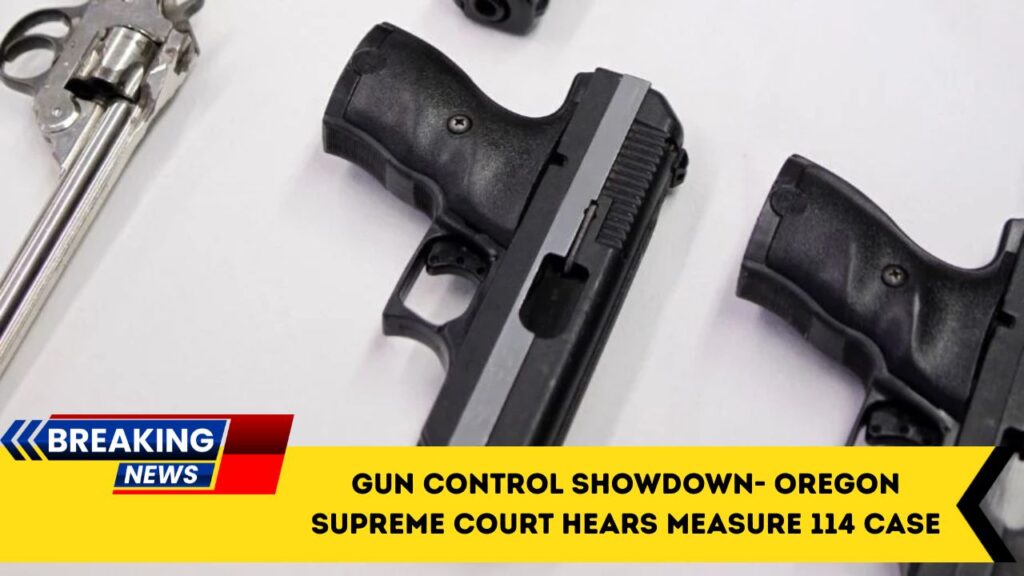A landmark legal battle is now before the Measure 114 controversy in Oregon, as the Oregon Supreme Court considers whether the gun-control initiative meets constitutional standards. At stake is the tension between gun ownership tradition and public safety concerns.
Passed narrowly by voters in November 2022, Measure 114 mandates a permit-to-purchase requirement, expanded background checks, and bans on high-capacity magazines.
This article explains the key provisions, the legal status, what the justices are weighing, and what this decision could mean for Oregon gun laws.
What Measure 114 Requires
Measure 114 introduces multiple changes to Oregon firearms law. Key provisions include:
- A permit-to-purchase system for firearms, requiring applicants to undergo training, fingerprinting, and a background check.
- A ban on magazines capable of holding more than 10 rounds.
- Expansion of background checks to transfers, effectively closing the so-called “Charleston loop-hole.”
Legal Timeline & Current Court Status
Since its passage, Measure 114 has faced continuous litigation. Below is a summary of the procedural timeline:
| Date | Event | Outcome |
|---|---|---|
| Nov 2022 | Measure 114 approved by voters (≈50.65% yes / 49.35% no) | Law passed narrowly |
| Jan 2023 | Trial court issues injunction preventing enforcement | Law remains on hold |
| Mar 12 2025 | Oregon Court of Appeals upholds constitutionality | Allows state appeal to Supreme Court |
| Present | Oregon Supreme Court reviewing case | Decision expected late 2025 / early 2026 |
What the Oregon Supreme Court Is Considering
The justices must decide whether the law, under Article I, Section 27 of the Oregon Constitution, “deprives the right to bear arms of any person to an unreasonable extent.” In doing so, the court will weigh:
- Whether the permit-to-purchase and training requirements are reasonable or create an undue burden on law-abiding citizens.
- If the ban on high-capacity magazines is compatible with Oregon’s gun ownership tradition and state constitutional protections.
- The extent to which public-safety interests—such as reducing gun violence or mass-shooting risk—justify the restrictions.
Legal experts believe the decision could hinge on precedent that allows regulation of “uniquely dangerous weapons or devices” if consistent with the state’s history of firearm regulation.
Implications for Gun Owners and Public Safety
If the law is upheld, Oregon will implement one of the strictest gun-control regimes in the nation. Gun-owners must navigate the new permit system and limits on magazines. Law-enforcement and licensing agencies will face higher administrative loads.
Proponents argue this could enhance public safety by reducing access to firearms and high-capacity magazines. Opponents argue it infringes on gun-owners’ rights and creates an expensive, burdensome regime.
If struck down, Measure 114’s provisions could be invalidated altogether or require revision—potentially sparking legislative efforts or ballot re-drafts.
What’s at Stake
- Gun-rights tradition: Oregon has a strong heritage of gun ownership for hunting, sport, and self-defence. A ruling upholding Measure 114 may signal a shift.
- Public safety goals: The state argues the measure addresses increasing gun-violence rates and high-capacity magazine risks.
- Operational implementation: If upheld, sheriffs, police and licensing agencies must build out systems for permits, training and compliance.
- Political precedent: The decision will influence how states regulate firearms amid national debates over gun laws.
The Oregon Supreme Court’s review of Measure 114 represents a pivotal moment at the crossroads of gun rights tradition and the state’s public-safety ambitions.
The court’s decision—which could arrive late in 2025 or early in 2026—will not only determine the fate of Oregon’s toughest-in-the-nation gun-control law but may reshape how states balance individual rights with collective safety.
For citizens and gun-owners alike, the outcome will carry far-reaching implications.
